By Peter Hossli (text) and Daniel Kellenberger (photos)
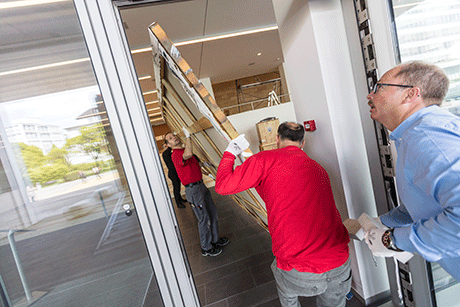
A diptych by American painter Nicole Eisenman (52) is supposed to breathe life into the lobby of the Ringier Axel Springer Medienpark building. It is comprised of two large rectangular oil paintings, each 16 feet long and 8 feet high, weighing around 130 pounds, both very valuable.
Before drilling a hole, chief technician Markus Edelmann (52) sounds out the wall intended for the paintings. It looms high above the concierges’ desk. He soon discovers what the architects failed to communicate – the brick wall is faced with half an inch of plasterboard over a two-and-a-half-inch cavity. «We need to find another way to mount these paintings,» says Edelmann.
He makes a quick decision: «Let’s postpone hanging the Eisenman to next Saturday.»
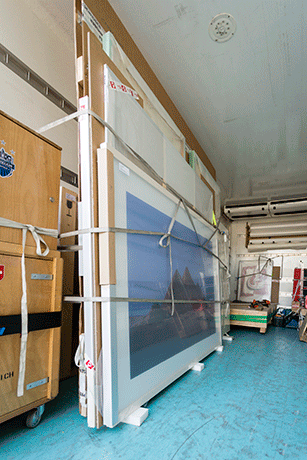
This cancellation does not cause any fuss. «When you collect art and put it on display, you know that patience and extreme caution are essential in handling the objects,» maintains Blättler, an art historian. «If you allow things to get hectic you risk making expensive mistakes.» It is her job «to do everything in my power to protect the art».
Altstetten is a neighborhood on Zurich’s western outskirts. It is the first Tuesday in May. The Medienpark, a modern glass and concrete building, soars above a side street. It has been home to the editorial offices of most of Ringier Axel Springer Schweiz’s German-language magazines since April. Spreading over two vast floors, about 600 people produce magazines like «Tele», «Bilanz», «Schweizer Illustrierte», «Beobachter» or «GlücksPost». The editors of the business weekly «Handelszeitung» report on black and red figures, their female counterparts at «Fashion Factory» on red and black gowns.
Contemporary art from Ringier AG’s collection is literally aimed to give them all pause. A team of curators has selected forty-eight works of art for this purpose. On the second floor are mostly photographs, the third is adorned with paintings, and on the executive floor there are both.
This measure is designed to achieve one of the main goals of publisher and collector Michael Ringier (68): The collection’s roughly 3,000 works of art are meant to be put on display and to delight the company’s employees.
That morning, the works that will soon be on view at the Medienpark wait in a Möbel-Transport AG truck. It is a firm specializing in shipping art, headquartered in Schlieren, west of Zurich. To keep artworks safe, the trucks are equipped with wheel suspension and a hold that may be refrigerated or heated. Prior to shipping, the wrapping material is acclimatized to the required temperature.
The cargo hold can accommodate objects of up to 10 feet in height. Today, that will be required. The paintings and photographs being delivered to the Medienpark are mostly large scale. Firstly, there are large walls to fill. Secondly, it is safer: The chance of anyone strolling out with a 10-ft. painting is slim.
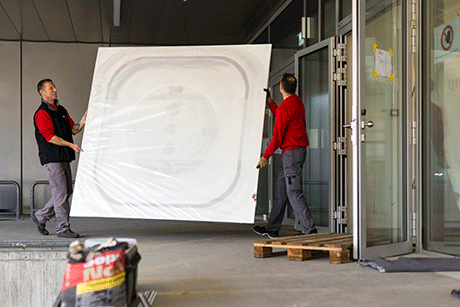
The art movers put metal plates down on the floor so it does not collapse under the paintings. They then heft the objects from the truck onto padded dollies. Framed photographs are wrapped in plastic while paintings are covered in vellum paper as well as bubble wrap and photographs mounted on aluminum are wrapped in cardboard.
They work fast, moving with precision. They barely talk. «Is this too high?» – «Should fit.» – «We need to unwrap it.» – «Sure.» – «On the side?» – «No use, it’s square.» – «Really?» – «Yes.» – «Let’s carry it inside then.»
Wrinkled noses
Within an hour, all the objects are in the hallways. Collection manager Blättler takes inventory. Each work of art has a title, a number and its own space at the Ringier storage facility outside Zurich.
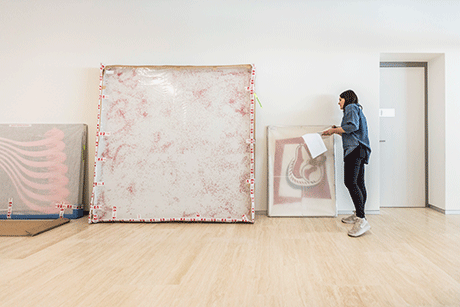
The «Pyramide» by the Swiss Duo Fischli/Weiss is now standing in the editorial offices of «Schweizer Illustrierte».
The technicians put the three-part photograph «The Magazine GRP» by the Irish-Israeli duo Clegg & Guttmann into the offices of «Fashion Factory». It depicts a somewhat stiff board of directors. «Is that really suitable?» a daringly dressed female editor asks, wrinkling her nose. Somehow, this is too masculine for her.
The technicians pick up the grass-green photograph «jpeg pk01» by German artists Thomas Ruff (59). «A joker,» explains collection manager Blättler: a work without a set place, which will only be hung if another piece is excluded.
They briefly put it on the floor, «which, technically, is forbidden,» says Edelmann. «But the carpeting is new and does not emit any particles.»
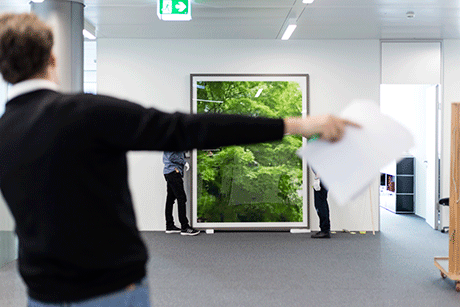
Wednesday morning. Each object is now in its determined space. Arthur Fink (26) walks through the Medienpark. The Ringier collection’s assistant curator is scanning the walls and rooms. He selected the art on his computer. This is the first time he has seen it in place. «And in space there are surprises.»
The photographs by Clegg & Guttmann that one of the editors described as «somehow too masculine»? «They feel out of place. They don’t fit esthetically,» Fink says and has them packed up.
What about the «Pyramide» by Fischli/Weiss? «Too small, it looks lost; we need something more vibrant here.» It’s too bland. «The texture and the color of the carpet swallow up the sand in front of the pyramids.»
He has the picture hung somewhere else and plays the joker. «Bring in the Ruff.» It is a large picture, fuzzy, pixelated, and it is hard to make out whether it is real. «It’s meta-photography,» explains Fink. «An image perfectly suited to a journalistic environment.» That’s right – pixilated, and hard to make out whether it is real. «It poses the question: what is photography?»
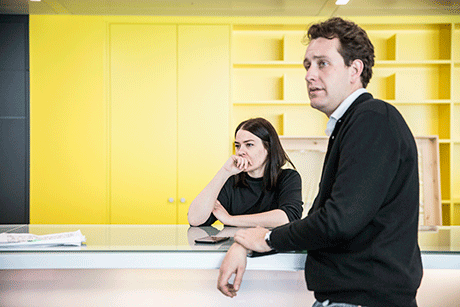
The joker fits
What matters to him at the end of the day is «that the picture finds its place in space.» He achieves this with his keen eye and his gut feeling. «I can’t explain it; I just see it.»
Fink is young, a student at Berlin’s Humboldt University. This may be why he is qualified to display contemporary art, which is fast-paced and supposed be young and fresh and cool and trenchant!
Fink takes a few steps back. «Shall we center it?» he asks. «Or do we hang it a couple of inches to the right?» Edelmann moves the object to the right. «Ah, the cone of light has a negative influence.» So it’s back to the center. Animating office buildings like the Medienpark with art is «completely different» from hanging art in museums, says Fink. «The lighting at the museum is conceived for art, and here it is designed for people’s workplaces.»
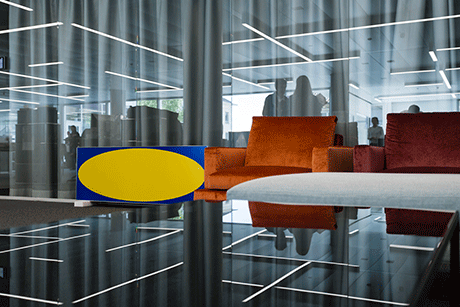
Is 4 ft. 8 in. better than 4 ft. 9 in.?
Only, what height is the center at? Around the globe, curators put the center of the picture anywhere between 4 ft. 7 in. and 4 ft. 11 in. from the floor. «I like 4 ft. 8 in.,» says the rather lanky Fink. «I am tall, Michael Ringier is even taller. I guess he would want them slightly higher than me.»
From lay-outers to bosses, reporters or photo editors – these visual stimuli are intended to yank them out of their daily grind. «Distract and stimulate,» says Fink.
He never forgets who he is making his choices for. Not every work in the Ringier collection could be put on display at the Medienpark. Not everyone is used to looking at contemporary art the way he is. He says that he often asks himself: Could a work of art be offensive to an employee? Is it pornographic? Or is it sufficiently accessible?
Hardly anyone pulls the emergency brake
The last word is with Michael Ringier and the collection’s long-time curator, Beatrix Ruf (57), director of Amsterdam’s Stedelijk Museum. Both receive lists, give notes, and rubber-stamp choices. Rarely does anyone pull the emergency brake.
Fink has been working for the Ringier Collection since 2015. Back then he was assisting with curating the 20-year anniversary. He was into literature and philosophy even as a teenager. «That led me to art.»
He wryly calls himself a «picture junkie» and says he enjoys dealing with real objects. «It’s great fun to move a picture just a few inches and see what happens in the space.»
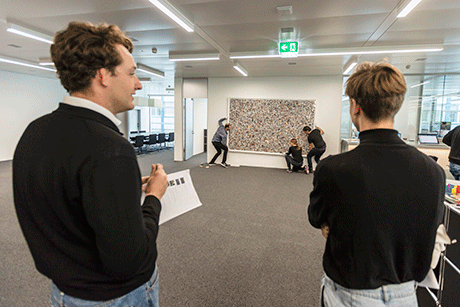
Initially, Shearer’s work was meant to go elsewhere. But with the sun shining on that wall, the ultraviolet rays could leach out the colors on photographic paper.
The height: 4 ft. 8 or 4 ft. 9? Two technicians are holding up «Guitar #5». «Make up your mind,» says chief technician Edelmann. «It weighs a ton.» They heft it up to 4 ft. 8 in. «Perfect. That’s what we’ll do,» says Fink. «Put it down.»
The sacred next to the profane
A lot of the time, things «that you just casually put there» work out, says Fink. Blättler and he are standing on the third floor in front of four contemporary paintings. They start to rearrange them. A process accompanied by short sentences. «That doesn’t look good.» – «Shall we put the Avery last?» – «Is that a disruption?» – «In terms of the shapes this is the most exciting.» – «I like the contrast with the yellow.» – «Wasn’t the first arrangement best?» – «Yes, let’s go back to the first one.» They were going around in circles, which they feel is a good thing. «We do have the time,» says Fink. «It is refreshing to be doing something uneconomical.»
Three days later, only three of the four paintings are displayed on the wall. After one night, Fink had decided that one was redundant.
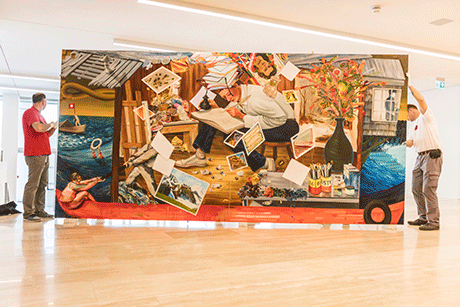
Unlike the photography, which needs to be self-reflective. «Photos focusing on the media,» says Fink, like so many in the Ringier collection.
The curator had five works by Heimo Zobernig (59), Austria’s most famous contemporary artist, brought out of storage. «He addresses the ultimate open questions of what an abstract painting can be,» Fink explains. He put up four of the paintings. What about the center point? For Zobernig’s work, 4 ft. 7 in. is ideal.
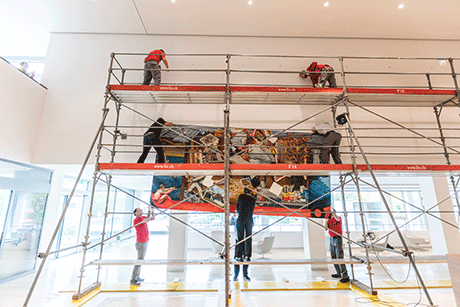
It is Saturday morning. Within two hours, workmen have built a three-story scaffold in the Medienpark lobby. The scissor lift originally envisaged for the job would be too heavy and likely to damage the delicate floor.
The spring-suspended and refrigerated Möbel-Transport truck is standing in front of the main entrance. A level casts a red laser beam onto the white wall, where bricks are overlaid with plaster and air.
Silently, the drill bores through the plasterboard, shrieking when it hits brick. A workman inserts six 4.5-inch reinforcing rods along the horizontal line marked by the red laser beam. Each rod can carry a load of 44 lbs. Each of the two pieces of Nicole Eisenman’s diptych «Progress: Real & Imagined» weighs 132 lbs.
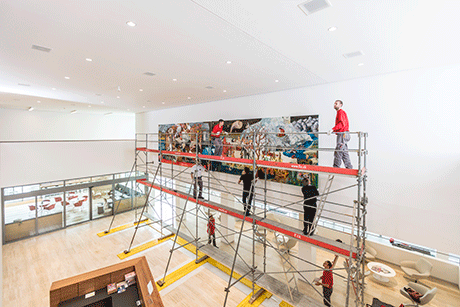
Hanging it is a delicate task requiring expertise and concentration. Eight men carry the first of the paintings in from the truck. They set it down between the scaffold and the wall. Two men climb up to the top of the scaffold, two to the middle, and at «Now!», four men raise the painting up from the floor. Few words are exchanged in the thirty seconds it takes to reach the height of twenty-two feet, guided by sixteen hands. «Okay.» – «Balance it out.» – «Careful.» – «Not so close to the scaffold.» – «Easy, easy.» – «Hold on.» – «I’ve got it.» – «That’s it.»
Once the second painting is hung, the movers eat their sandwiches. In the afternoon, the scaffolders will take apart the frame they built. The artworks in the open-plan offices are mounted on the walls – a total of 31 objects. Now they can start distracting.
